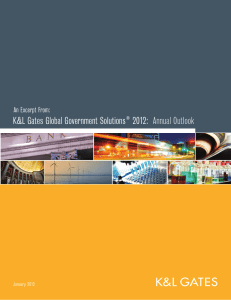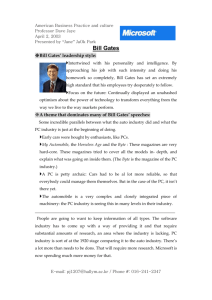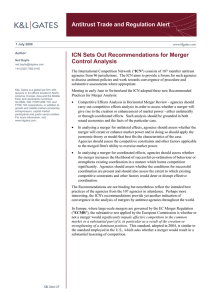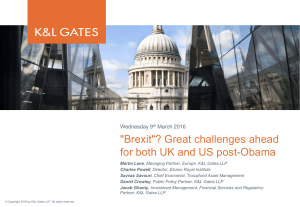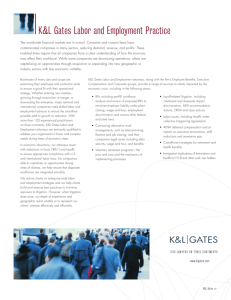Antitrust and Trade Regulation Alert New Guidance for Merging Companies:
advertisement
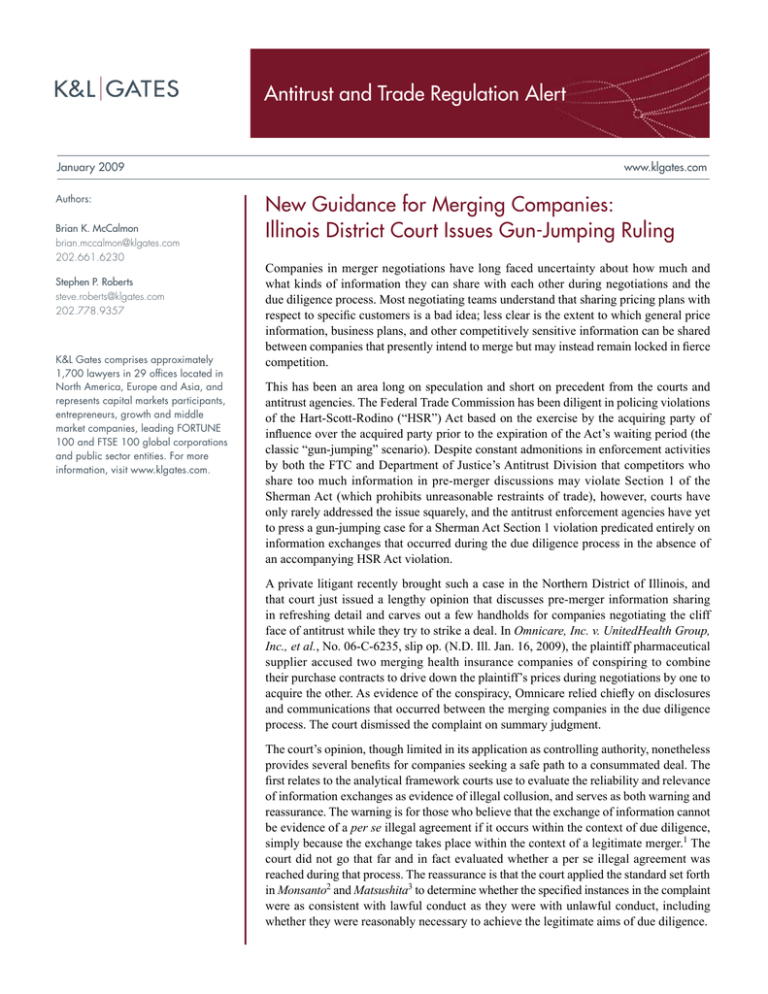
Antitrust and Trade Regulation Alert January 2009 Authors: Brian K. McCalmon brian.mccalmon@klgates.com 202.661.6230 Stephen P. Roberts steve.roberts@klgates.com 202.778.9357 K&L Gates comprises approximately 1,700 lawyers in 29 offices located in North America, Europe and Asia, and represents capital markets participants, entrepreneurs, growth and middle market companies, leading FORTUNE 100 and FTSE 100 global corporations and public sector entities. For more information, visit www.klgates.com. www.klgates.com New Guidance for Merging Companies: Illinois District Court Issues Gun-Jumping Ruling Companies in merger negotiations have long faced uncertainty about how much and what kinds of information they can share with each other during negotiations and the due diligence process. Most negotiating teams understand that sharing pricing plans with respect to specific customers is a bad idea; less clear is the extent to which general price information, business plans, and other competitively sensitive information can be shared between companies that presently intend to merge but may instead remain locked in fierce competition. This has been an area long on speculation and short on precedent from the courts and antitrust agencies. The Federal Trade Commission has been diligent in policing violations of the Hart-Scott-Rodino (“HSR”) Act based on the exercise by the acquiring party of influence over the acquired party prior to the expiration of the Act’s waiting period (the classic “gun-jumping” scenario). Despite constant admonitions in enforcement activities by both the FTC and Department of Justice’s Antitrust Division that competitors who share too much information in pre-merger discussions may violate Section 1 of the Sherman Act (which prohibits unreasonable restraints of trade), however, courts have only rarely addressed the issue squarely, and the antitrust enforcement agencies have yet to press a gun-jumping case for a Sherman Act Section 1 violation predicated entirely on information exchanges that occurred during the due diligence process in the absence of an accompanying HSR Act violation. A private litigant recently brought such a case in the Northern District of Illinois, and that court just issued a lengthy opinion that discusses pre-merger information sharing in refreshing detail and carves out a few handholds for companies negotiating the cliff face of antitrust while they try to strike a deal. In Omnicare, Inc. v. UnitedHealth Group, Inc., et al., No. 06-C-6235, slip op. (N.D. Ill. Jan. 16, 2009), the plaintiff pharmaceutical supplier accused two merging health insurance companies of conspiring to combine their purchase contracts to drive down the plaintiff’s prices during negotiations by one to acquire the other. As evidence of the conspiracy, Omnicare relied chiefly on disclosures and communications that occurred between the merging companies in the due diligence process. The court dismissed the complaint on summary judgment. The court’s opinion, though limited in its application as controlling authority, nonetheless provides several benefits for companies seeking a safe path to a consummated deal. The first relates to the analytical framework courts use to evaluate the reliability and relevance of information exchanges as evidence of illegal collusion, and serves as both warning and reassurance. The warning is for those who believe that the exchange of information cannot be evidence of a per se illegal agreement if it occurs within the context of due diligence, simply because the exchange takes place within the context of a legitimate merger.1 The court did not go that far and in fact evaluated whether a per se illegal agreement was reached during that process. The reassurance is that the court applied the standard set forth in Monsanto2 and Matsushita3 to determine whether the specified instances in the complaint were as consistent with lawful conduct as they were with unlawful conduct, including whether they were reasonably necessary to achieve the legitimate aims of due diligence. Antitrust and Trade Regulation Alert The second benefit for the business community is the court’s application of this analysis to specific information exchanges that many merging parties undertake (or would like to): • The parties exchanged strategic information about the average price of contracted services at due diligence meetings between CEOs, CFOs, and other senior executives; the court held that the exchanges were necessary for the acquiring party to evaluate the deal and that the exchange of average pricing did not support an inference of conspiracy because it was not inconsistent with the belief that the two entities were still acting independently. The court was careful to distinguish the exchange of average prices from the exchange of specific prices to customers, which the court noted would be more troublesome; • Although the parties had instituted a firewall around the due diligence teams, they consulted with other members outside the firewall; the court held this was a reasonable measure designed to add context to the shared information; • The parties shared a generic form contract that was ultimately used between the acquisition target’s subsidiary and the plaintiff; the court held that this was insignificant because nothing in the document communicated specific pricing information; • The acquired party disclosed its expected average discounts on products it purchased; the court found this consistent with necessary due diligence because the acquiring company requested information regarding only discount “averages and ranges,” requested the information late in the merger process, and was “appropriately circumspect” in its request; and • The acquiring party disclosed the average brand discount on drugs it received; the court noted that this information sharing was more problematic than pricing data of the acquired company as the acquiring company typically has more reason to receive information than to disclose it, but ruled that because it was shared cautiously, in a sealed envelope via a disqualified negotiator, and was shared merely in order to prove the company was well run and has a strong strategic vision, the disclosure was not evidence of an illegal agreement. Third, merging parties can draw some guidance from what the court specifically noted that the parties did not do. For example, the court noted the absence of extensive discussions between the merging entities about the plaintiff’s contract. In addition, recognizing that merging parties’ need for information often decreases once a merger agreement is executed, the court noted favorably that the parties shared no pricing or strategic information, general or specific, after they signed an agreement to merge. The district court provided an outline of the framework under which future courts may evaluate pre-merger information sharing. Those looking for a unified theory of pre-merger gun-jumping, however, must continue to search. This is only one district court’s opinion and other courts may disagree. More importantly, the court’s ruling was highly dependent on the facts of the case before it—as most (if not all) collusion cases must be. For example, the court evaluated the proffered evidence within the context of a consummated merger by the defendants, eliminating any possibility that the parties were engaged in due diligence to cover an intent to collude. Effectively, the court was asked to decide whether pre-merger information sharing could be evidence of intent to eliminate competition that existed in the time between the information exchanges and the closing of the merger itself (after which the parties were incapable of conspiring). Viewed in that light, it is little wonder that in the absence of ironclad evidence of price collusion, the court dismissed the complaint and gave the back of its hand to the plaintiff’s theories. Companies that have not yet closed should therefore take the court’s opinion with a grain of salt when determining whether to apply the same rationale to decisions regarding their own conduct. Nevertheless, one more court’s extensive discussion of pre-merger information sharing helps to clarify an area of law where there has been scant guidance. January 2009 | 2 Antitrust and Trade Regulation Alert Endnote 1 The merger had occurred before the case was filed, so there was never any allegation that the discussions were merely a cover for illegal collusion. 2 Monsanto Co. v. Spray-Rite Serv. Corp., 465 U.S. 752 (1984). 3 Matsushita Elec. Indus. Co. v. Zenith Radio Corp., 475 U.S. 574 (1986). Anchorage Austin Beijing Berlin Boston Charlotte Dallas Fort Worth Frankfurt Harrisburg Hong Kong London Los Angeles Miami Newark New York Orange County Palo Alto Paris Pittsburgh Portland Raleigh Research Triangle Park San Francisco Seattle Shanghai Spokane/Coeur d’Alene Taipei Washington, D.C. K&L Gates comprises multiple affiliated partnerships: a limited liability partnership with the full name K&L Gates LLP qualified in Delaware and maintaining offices throughout the U.S., in Berlin, in Beijing (K&L Gates LLP Beijing Representative Office), and in Shanghai (K&L Gates LLP Shanghai Representative Office); a limited liability partnership (also named K&L Gates LLP) incorporated in England and maintaining our London and Paris offices; a Taiwan general partnership (K&L Gates) which practices from our Taipei office; and a Hong Kong general partnership (K&L Gates, Solicitors) which practices from our Hong Kong office. K&L Gates maintains appropriate registrations in the jurisdictions in which its offices are located. A list of the partners in each entity is available for inspection at any K&L Gates office. This publication is for informational purposes and does not contain or convey legal advice. The information herein should not be used or relied upon in regard to any particular facts or circumstances without first consulting a lawyer. ©2009 K&L Gates LLP. All Rights Reserved. January 2009 | 3

